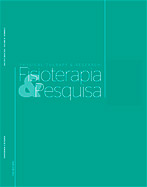Influence of the malleolar marker position on postural parameters in the sagittal plane
DOI:
https://doi.org/10.1590/1809-2950/18012625042018Abstract
Photogrammetry is a postural evaluation method that provides information based on the reference of anatomical markers. In the sagittal plane, one of the main evaluations is related to the plumb line; however, the literature shows divergences regarding the placement of the malleolar reference marker. Some argue that it must be placed exactly on the center of the lateral malleolus, while others defend placing it slightly in front of the lateral malleolus. This study aimed to identify whether the modification of the position of the malleolar marker affects the results of the procedure. This is a cross-sectional analytical observational study, with comparative intrasubject design. Forty-four healthy subjects (25 women and 19 men; 27±6 years old; 170±11 cm; 71±15 kg) were evaluated using protocol and software DIPA© for investigation of the variables (plumb line test and pelvic version) in the sagittal plane, with the malleolar marker in two positions: (1) in the center of the lateral malleolus and (2) in front of the lateral malleolus. The analysis was carried out according to descriptive (frequency distribution, mean and standard deviation) and inferential (ShapiroWilk test, dependent Student's t-test, and Wilcoxon test, α=0.05) statistical methods. For both variables, the malleolar marker position presented statistically significant difference (p<0.05) only on the scalar value, not significantly affecting the posture classification. The results suggest that the vertical reference point for photogrammetry, based on the malleolar marker, can be chosen by the evaluator
Downloads
References
Furlanetto TS, Sedrez JA, Candotti CT, Loss JF. Photogrammetry
as a tool for the postural evaluation of the spine: a systematic
review. World J Orthop. 2016;7(2):136-48. doi: 10.5312/wjo.
v7.i2.136
Sacco ICN, Picon AP, Ribeiro AP, Sartor CD, Camargo-Junior F,
Macedo DO, et al. Effect of image resolution manipulation in
rearfoot angle measurements obtained with photogrammetry.
Braz J Med Biol Res. 2012;45(9):806-10. doi: 10.1590/
S0100-879X2012000900003.
Santos JDM, Oliveira MA, Silveira NJF, Carvalho SS, Oliveira
AG. Confiabilidade inter e intraexaminadores nas mensurações
angulares por fotogrametria digital e goniometria. Fisioter Mov.
;24(3):389-400. doi: 10.1590/S0103-51502011000300003
Sedrez JA, Furlanetto TS, Noll M, Gontijo KNS, da Rosa BN,
Candotti CT. Relação entre alterações posturais e hábitos de vida
de escolares do ensino fundamental. Rev Baiana Saúde Pública.
;38(2):279-96. doi: 10.5327/Z0100-0233-2014380200005
Antoniolli A, Candotti CT, Gelain GM, Schmit EFD, Ducatti
LMA, Melo MO, et al. Influence of feet position on static
postural assessment by means of photogrammetry: a
comparative study. Eur J Physiother. 2018;20(3):166-71. doi:
1080/21679169.2018.1435719
Ruivo RM, Pezarat-Correia P, Carita AI. Intrarater and interrater
reliability of photographic measurement of upper-body
standing posture of adolescents. J Manipulative Physiol Ther.
;38(1):74-80. doi: 10.1016/j.jmpt.2014.10.009
Peninou G. Examen de la posture erigée, position de la ligne de
gravité et de l’axe tragien. Ann Kinésither. 1982;9(9):389-402.
Kendall FP, Mccreary EK, Provance PG, Rodgers MM, Romani
WA. Músculos: provas e funções. com postura e dor. 5 ed. São
Paulo: Manole; 2007.
Sedrez JA, Da Rosa MIZ, Noll M, da Silva Medeiros F, Candotti CT.
Fatores de risco associados a alterações posturais estruturais da coluna vertebral em crianças e adolescentes. Rev Paul
Pediatr. 2015;33(1):72-81. doi: 10.1016/j.rpped.2014.11.012
Quirino CM, Porto AB, Faquin BS, Junior AA, Macedo CS,
Okazaki VHA. Reprodutibilidade intra avaliador e inter
avaliadores na identificação digital da posição dos marcadores
de referência na avaliação postural de fotogrametria. Rev
Bras Ciênc Mov. 2015;23(3):143-50. doi: 10.18511/0103-1716/
rbcm.v23n3p143-150
Furlanetto TS, Candotti CT, Comerlato T, Loss JF. Validating
a postural evaluation method developed using a Digital
Image-based Postural Assessment (DIPA) software. Comput
Methods Programs Biomed. 2012;108(1):203-12. doi: 10.1016/j.
cmpb.2012.03.012
Rosa BN da, Furlanetto TS, Noll M, Sedrez JA, Schmit EFD,
Candotti CT. 4-year longitudinal study of the assessment of body
posture, back pain, postural and life habits of schoolchildren.
Motricidade. 2017;13(4):3-12. doi: 10.6063/motricidade.9343
Sacco I, Melo M, Rojas G, Naki I, Burgi K, Silveira L, et al. Análise
biomecânica e cinesiológica de posturas mediante fotografia
digital: estudo de casos. Rev Bras Ciênc Mov. 2008;11(2):25-34.
Field A. Discovering statistics using SPSS. Los Angeles, USA:
Sage, 2009.
Iunes DH, Elias IF, Carvalho LC, Dionísio VC. Postural
adjustments in young ballet dancers compared to age
matched controls. Phys Ther Sport. 2016;17:51-7. doi: 10.1016/j.
ptsp.2015.04.004
Araújo FA, Severo M, Alegrete N, Howe LD, Lucas R. Defining
patterns of sagittal standing posture in girls and boys of school
age. Phys Ther. 2016;97(2):258-67. doi: 10.2522/ptj.20150712
Moriguchi CS, Carnaz L, Silva LC, Salasar LE, Carregaro RL,
Sato Tde O, et al. Reliability of intra-and inter-rater palpation
discrepancy and estimation of its effects on joint angle
measurements. Man Ther. 2009;14(3):299-305. doi: 10.1016/j.
math.2008.04.002
Nunes Junior PC, Teixeira ALM, Gonçalves CR, Monnerat E,
Pereira JS. Os efeitos do método pilates no alinhamento
postural: estudo piloto. Fisioter Ser. 2008;3(4):210-5.
Noll M, da Rosa BN, Candotti CT, Furlanetto TS, Gontijo KNS,
Sedrez JA. Alterações posturais em escolares do ensino
fundamental de uma escola de Teutônia/RS. Rev Bras Ciênc
Mov. 2012;20(2):32-42.
da Rosa BN, Noll M, Sedrez JA, Furlanetto TS, Candotti CT.
Monitoring the prevalence of postural changes in schoolchildren.
J Phys Ther Sci. 2016;28(2):326-31. doi: 10.1589/jpts.28.326
Batistão MV, Carnaz L, Barbosa LF, da Motta GC, Sato TO.
Posture and musculoskeletal pain in eutrophic, overweighed,
and obese students: a cross-sectional study. Motriz Rev Educ
Fís. 2014;20(2):192-9. doi: 10.1590/S1980-65742014000200009
Paušić J, Pedišić Ž, Dizdar D. Reliability of a photographic
method for assessing standing posture of elementary school
students. J Manipulative Physiol Ther. 2010;33(6):425-31. doi:
1016/j.jmpt.2010.06.002
Downloads
Published
Issue
Section
License
Copyright (c) 2018 Fisioterapia e Pesquisa

This work is licensed under a Creative Commons Attribution-ShareAlike 4.0 International License.



